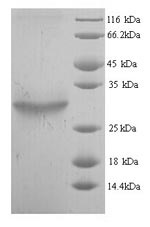Recombinant Escherichia coli 1-acyl-sn-glycerol-3-phosphate acyltransferase (plsC) is produced using a yeast expression system and represents the full-length protein, spanning amino acids 1-245. The protein includes an N-terminal 6xHis-tag, which helps with purification and detection. SDS-PAGE analysis confirms a purity level greater than 90%, suggesting good reliability for research applications. This product is intended for research use only and is not suitable for therapeutic applications.
1-acyl-sn-glycerol-3-phosphate acyltransferase (plsC) appears to play a critical role in bacterial lipid biosynthesis, particularly in phospholipid formation. The enzyme catalyzes the acylation of lysophosphatidic acid to form phosphatidic acid, an essential precursor in membrane phospholipid biosynthesis. For researchers focusing on bacterial lipid metabolism and membrane dynamics, studying this enzyme may be crucial for understanding these complex pathways.
Potential Applications
Note: The applications listed below are based on what we know about this protein's biological functions, published research, and experience from experts in the field. However, we haven't fully tested all of these applications ourselves yet. We'd recommend running some preliminary tests first to make sure they work for your specific research goals.
Based on the provided information, recombinant E. coli PlsC is produced in a yeast expression system as a full-length protein (1-245aa) with an N-terminal 6xHis-tag. PlsC is a membrane-associated enzyme that catalyzes a key step in phospholipid biosynthesis and typically requires proper membrane integration and specific lipid environments for full activity. While yeast expression systems provide eukaryotic folding machinery capable of supporting disulfide bond formation and some post-translational modifications, membrane proteins like PlsC present particular challenges as they often require specific lipid bilayers for correct folding and function. The full-length nature of the protein is advantageous, but the absence of a membrane environment during expression may compromise proper folding. The small His-tag is unlikely to significantly interfere with protein function. Purity >90% by SDS-PAGE indicates good production quality but does not confirm native folding or bioactivity, especially for membrane proteins. No validation data (e.g., enzymatic activity assays, membrane integration tests) are provided. Therefore, while the protein has a reasonable probability of being soluble and partially folded, its enzymatic activity and proper folding cannot be confirmed without experimental validation.
1. Biochemical Characterization of Bacterial Phospholipid Biosynthesis
Membrane enzyme activity depends on lipid environment; soluble expression may not support functional folding. If correctly folded and functional, this recombinant PlsC could be used to study enzymatic properties and kinetics in vitro. However, as a membrane-associated enzyme, PlsC requires a proper lipid environment for activity. If misfolded or lacking the necessary membrane context (likely in soluble expression), activity assays would yield invalid results. The His-tag facilitates purification, but activity validation in appropriate lipid systems is essential.
2. Inhibitor Screening and Drug Discovery Research
Drug screening requires native enzyme conformation; improper folding compromises screening validity. If properly folded and active in appropriate assay conditions, PlsC could serve as an antibacterial target for screening. However, if the enzyme is not functionally reconstituted (probably without membrane mimetics), screening would identify false positives/negatives. The soluble nature may not represent the native membrane-bound conformation relevant for drug discovery.
3. Protein-Protein Interaction Studies
Membrane protein interactions often depend on lipid environment; the soluble form may not capture native interactions. If correctly folded, the His-tagged PlsC could be used in pull-down assays to identify interaction partners. However, as a membrane protein, many genuine interactions may require membrane context. If misfolded, interaction domains may be altered, leading to non-specific binding.
4. Structural Biology and Protein Folding Studies
Membrane protein structure determination requires special conditions; the soluble form may not reflect the native conformation. If properly folded, the protein could be used for structural studies, but membrane protein crystallization requires special handling. The soluble expression form may not represent the native membrane-bound structure. If misfolded, structural data would be biologically irrelevant.
5. Antibody Development and Immunological Research
Antibodies can be generated, but may have limited utility for native membrane protein detection. This application is suitable, as antibody generation primarily relies on linear epitope recognition. However, antibodies against the soluble form may not optimally recognize membrane-associated PlsC in native bacterial contexts.
Final Recommendation & Action Plan
This yeast-expressed PlsC requires rigorous validation before functional applications due to the challenges of expressing functional membrane proteins in soluble form. The recommended action plan includes: (1) Validate enzymatic activity using appropriate lipid-based assay systems (e.g., liposomes or detergents); (2) Test membrane integration capability; (3) For structural studies, consider membrane mimetic environments; (4) Antibody development can proceed but validate against native membrane-associated PlsC; (5) For interaction studies, confirm findings with full-length membrane-associated protein. If validation fails, consider expression in membrane protein-friendly systems (e.g., E. coli with membrane extraction) or use nanodisc reconstitution. Always include appropriate controls (membrane fractions, known active enzymes) to ensure biological relevance.






